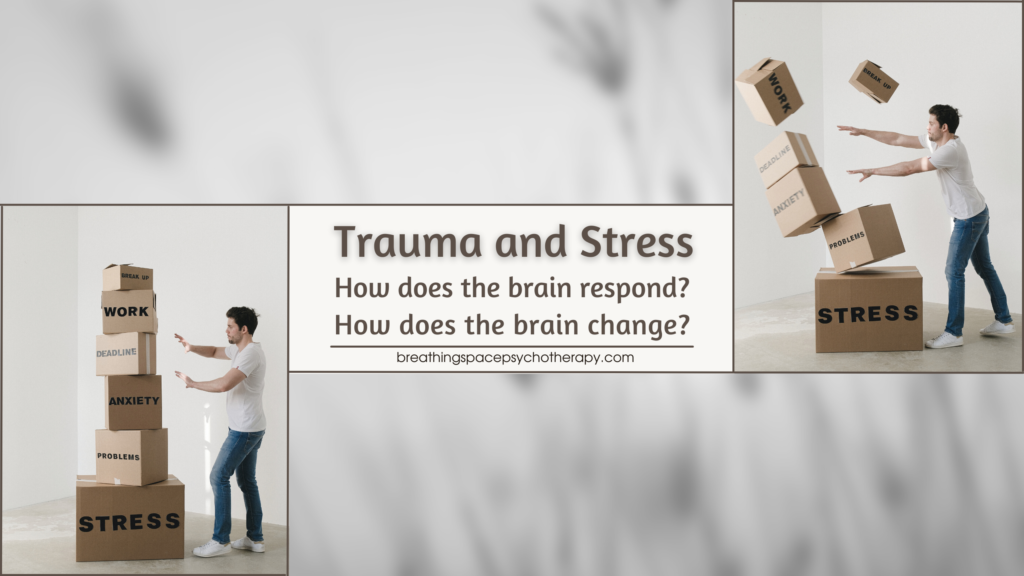What is stress?
Stress is a physical, emotional, and psychological response to changes (or stressors) in an individual’s life. It is normal and important for an individual’s learning and development.
Types of Stress
Stress isn’t always negative; it can also be positive. According to VeryWellMind, types of stress include acute stress, chronic stress, episodic acute stress, and eustress.
Acute Stress
Acute stress is short-term and is what we most often encounter in our day-to-day lives. The stressor can be positive or negative/distressing.
The stressor triggers the body’s fight-flight-freeze response. Once the perceived threat is gone, the body’s systems are designed to return to a calm state (the “rest and digest” state; or normal functioning).
People may also have serious acute stress, such as car accidents and natural disasters, which can be traumatic.
Chronic Stress
Chronic stress is long-term.
It can occur when an individual experiences continuous acute stress or a traumatic event. This means that the individual is in a near-constant state of “fight, flight, or freeze”—i.e. the automatic nervous system is overactive. The individual does not experience a calm state (or a relaxation response) often enough.
Prolonged stress can lead to burnout, anxiety disorders, and depression, and it can damage your body.
Episodic Acute Stress
Episodic acute stress is acute stress that occurs with regularity or frequency. This can create a life of ongoing distress.
Eustress
Eustress is a positive form of stress that keeps you energized. It is the opposite of distress and is characterized by feelings of happiness, accomplishment, and excitement in response to a stressor.
What is trauma?
“Trauma is an experience, not an event.” ―Polyvagal Institute
Trauma is an emotional response to a single or series of distressing event(s), which are perceived as threatening. Witnessing a threat to a loved one or fearing a loved one’s life and physical and psychological security can also be a traumatic experience.
However, if a person experiences a distressing event, it does not necessarily mean they are experiencing trauma.
Types of Trauma
Trauma can occur at any point in an individual’s life: from infancy, childhood, and adolescence to adulthood and old age. It can also occur in any setting: home, school, community, workplace, war zone, or even online. Traumatic events may include but are not limited to:
- Child maltreatment: physical abuse, emotional or psychological abuse, neglect, and sexual abuse
- Adverse childhood experiences
- Domestic violence
- Trafficking
- Terrorism
- Refugee and war experiences (including torture)
- Military family-related stressors
- Serious accidents or life-threatening illnesses
- Medical trauma, childbirth, hospitalization
- The unexpected or violent death of a loved one
- Intergenerational trauma
- Bullying (including cyberbullying), school shootings, or community violence
Types of trauma are most commonly categorized as big “T” trauma and little “t” trauma, but trauma is a spectrum of experiences. This means that two (and more) people can have different responses to the same event.
Shock or Acute Trauma
Typically referred to as big “T” trauma. This is an emotional response to a single distressing event.
Examples:
- a mugging or robbery
- mass shooting
- natural disaster
- a serious accident.
Chronic Trauma
Chronic trauma refers to a long-term emotional response to repeating, prolonged, distressing events. These events may or may not be connected.
Examples:
- bullying or cyberbullying
- domestic violence
- multiple unrelated traumatic experiences (e.g. moving cities, experiencing medical trauma, and getting into a car accident).
Developmental/Relational Trauma or Complex Childhood Trauma
This type of trauma refers to repetitive, prolonged traumatic experiences that occur in early life or during critical development periods.
This trauma often involves an interpersonal relationship, such as a caregiver or family member, and as such interferes with the child’s ability to form a secure attachment.
Examples:
- child maltreatment
- sibling abuse
- attachment trauma
- divorce or caregivers arguing in the home.
Historical, collective, or intergenerational trauma
This type of trauma is inherited through generations and different cultural groups. The changes of trauma are inherited by altering how the gene functions (i.e. epigenetically).
Examples:
- racism
- slavery
- patriarchy
- war
- genocide
- forcible removal from family.
Vicarious or Secondary Trauma
Vicarious or secondary trauma refers to exposure to another person’s traumatic stories or experiences. This is not the same as burnout. This trauma can result in symptoms parallel to post-traumatic stress disorder (PTSD).
For example, a professional who works with trauma survivors may develop experience vicarious trauma.
Little “t” Trauma
Little “t” trauma refers to experiences that are a part of everyday life but may be traumatic.
Examples:
- losing a job
- moving to a new house
- Infidelity
- divorce
- challenging friendships.
How does the brain respond to trauma and stress?
When an individual experiences stress, the brain triggers a chemical reaction that temporarily adjusts the body’s blood pressure, heart rate, breathing, metabolism, and other functions in the brain. These temporary adjustments allow the individual to pay attention to the perceived threat and take the actions needed to survive—in other words, the brain engages in “fight, flight, or freeze” mode.
The automatic nervous system (ANS) regulates bodily functions and is responsible for these temporary adjustments. ANS is divided into three branches: the sympathetic system (or the “fight-flight” system), the parasympathetic system (or the “rest and digest” system), and the enteric nervous system.
ANS has 3 general states for survival:
- Calm: in this state, there is no perceived threat—you feel calm, relaxed, and connected with others.
- Mobilized: in this state, there is a perceived threat and your brain activates the fight-or-flight response. Epinephrine (i.e. adrenaline) and cortisol are released; your heart rate, blood pressure, and breathing increase, while metabolism decreases.
- Immobilized: in this state, there is an overwhelming perceived threat and your brain activates the freeze response. The freeze response activates both the sympathetic and parasympathetic systems.
- Sympathetic system activity is expressed by decreased metabolism, increased heart rate, cardiac output, respiration, and pain suppression;
- Parasympathetic system activity is expressed by a heart rate deceleration.
These states are often blended together based on the activity, and we automatically flow through the different states.
When we experience trauma and chronic stress, however, the ability to move fluidly between states becomes inhibited. The individual is perpetually in a fight-flight-freeze state because they perceive threats even in benign environments.
What areas of the brain are affected by trauma?
There are three important regions of the brain that are involved in the stress response: the amygdala, hippocampus, and ventromedial prefrontal cortex. Trauma can result in long-term changes in the brain’s circuits that are involved in the stress response.
The Amygdala
The amygdala is involved with functions related to memory, emotion, and the body’s fight-flight-freeze response.
The amygdala is designed to detect and react to cues of safety and danger. When the amygdala detects danger, it sends a distress signal to the hypothalamus, the command center of the brain; the hypothalamus then releases the stress hormones, epinephrine (i.e. adrenaline) and cortisol.
How is the amygdala affected by trauma? After trauma, the amygdala becomes hyperactive and highly attuned to potential threats. This means the individual is hypervigilant, always scanning the environment for danger—which takes a lot of energy,—and leading the individual to have strong emotional responses to traumatic reminders. This heightened attention to threats inhibits an individual’s ability to pay attention and interact with people.
The Hippocampus
The hippocampus is involved with memory, learning, and emotional responses. It stores, retrieves, and regulates emotional memories.
How is the hippocampus affected by trauma? After trauma, people with PTSD demonstrate deficits in verbal declarative memory. This deficit is associated with smaller volume in the hippocampus, which is due to elevated stress hormones. They also demonstrated deficits in autobiographical memory, gaps in memory for everyday events (referred to as dissociative amnesia), and an attentional bias for trauma-related material.
The Medial Prefrontal Cortex
The medial prefrontal cortex (mPFC) helps regulate emotional responses by inhibiting the amygdala and plays a role in decision-making, consolidation of memories, and fear extinction memory.
Fear extinction is an active learning process in which the individual learns to associate a fear-eliciting stimulus with the absence of an aversive event. The mPFC promotes fear extinction by inhibiting the amygdala’s output and thus suppressing fear. Fear inhibition is mediated by the mPFC inhibiting the amygdala and is consolidated by the ventral region of the mPFC.
How is the ventromedial prefrontal cortex affected by trauma? After trauma, people with PTSD show a decrease in medial prefrontal function during attention tasks and exposure to traumatic reminders. They also show a decrease in blood flow in the mPFC during fear extinction tasks. This means mPFC is not as effective at inhibiting the amygdala’s responses to traumatic reminders or fear-eliciting stimuli even when the acute threat is no longer present.
Are these changes permanent?
No, the changes in the brain when an individual experiences trauma are not permanent due to neuroplasticity.
Neuroplasticity refers to the brain’s capacity to change and adapt in response to an experience by reorganizing its structures, functions, and connections. Neuro refers to neurons, the building blocks of the nervous system; and plasticity refers to the brain’s malleability, or ability to change.
While brains are more malleable at a young age, neuroplasticity shows that the brain can change and adapt at any age. More importantly, this means that the brain can reorganize itself as a result of healing and therapeutic experiences.





